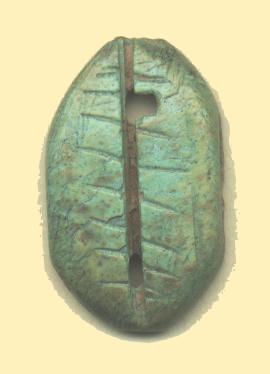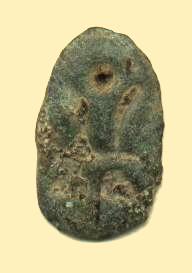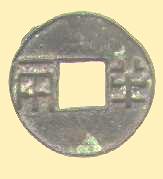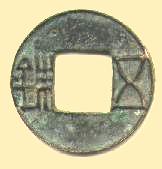|
|
EARLY |
|
|
EARLY |
Shang Dynasty circa 17th- 11th Centuries BC
Cowrie Shells
From the vast numbers of cowrie shells found in tombs of the Shang Dynasty it seems that the Chinese used them as a means of exchange as early as the 16th Century BC. This was a period when China moved into the Bronze Age. The Shang kingdom, basically the Huang Ho river basin, comprised the area between what is now Shensi Province in the west to the sea and lay between Hopeh in the north and the Yangtze River in the south. They were not the only people to use cowries, as instanced by similar finds in Mesopotamia and parts of Europe, but these came much later. The use of cowries and later imitations of cowries made of bone or bronze continued through the Zhou Dynasty (11th - 8th Centuries BC). Some bronzes had value marks on them, expressed in cowries (peng = two strings of 10 cowries)

Shang Dynasty Bone cowrie
Zhou Dynasty circa 11th- 3rd Centuries BC
The Zhou Dynasty originated in Shensi and under Wen Wang quickly grew to rival the power of the Shang, though it was his son, Wu Wang, who completed the conquest. For two centuries Zhou rulers enjoyed peace but then the feudal structure disintegrated and for three hundred years China entered what is known as the Spring and Autumn period (Chun Qiu) during which the kingdom split up into various groups of states ruled by Overlords (pa). Among the most prominent were the eastern state of Qi in the Shandong Peninsula, Wei in the centre, Qin (which had originally assumed power in Shensi) and Chu in the south. A period of internecine struggle and chaos followed and gradually the whole empire split up into small kingdoms. This is known as the period of Warring States (Zhan Kuo) and lasted until 221 BC when the kingdom was reunited under Qin Shi Huang, ruler of Qin.
Spade Money
From the 8th Century BC onwards shovel-shaped coins, known as Bu Bi circulated. These were made of cast bronze and came in a two main shapes:
Kong Shou Bu - These had a hollow handle and sharply pointed feet.
Ping Shou Bu - These were flat headed, with pointed feet.
Later Bu Bi were square-footed, some decorated with Chinese characters of primitive form. Bu reached their zenith during the Warring States period and mostly circulated in the central plains area of Qin, Zhao, Han and Wei.
Knife Money
These evolved at the same time as spade money and originated in the state of Qi, east of the Yellow River, and were called Dao Bi. They were miniature representations of a bronze implement called Xue. The handle of the knife was ridged, with a ring at the end. The blade was shaped like a scimitar and often bore Chinese characters. By the 4th Century BC they had spread to the adjacent states of Yan and Zhao and in their final form, known as Ming Zi Dao, they were far less pointed and much smaller in size.

Late 4th Century BC Ming Zi Dao Knife Money of the State of Yan
Ring-shaped Coins
Known as Huan Qian, these were of cast bronze and bore a central circular hole. They were among the first round coins ever produced, dating from the period of Warring States. Huan Qian bore marks in primitive Chinese characters denoting place of mintage and their value. They circulated in the states of Chu, Wei and Zhao.
Ant Nose or Devil-Faced Money
These were of cast bronze, flat on the reverse and shaped like a teardrop. At the smaller end there was usually a hole. The term "Devil-faced money" was derived from the characters on the front resembling a human face. They were also referred to as "Ant noses" because of their alleged use in preventing ants getting into dead bodies by inserting them in the nose and ears. The Chinese name for such coins was Yi Bi and they were in use from the 8th Century BC onwards.

"Ant Nose" money
Early Gold Coins
Known as Ying Yuan, these consisted of a square cube of gold, impressed with Chinese characters. The earliest examples date from the 3rd Century BC in the state of Chu.
Qin Dynasty 221-206 BC
The Reforms of Qin Shi Huang 221-207 BC - Ban Liang
Qin Shi Huang (Shi Huang Ti), first emperor of the Qin Dynasty, overhauled the monetary system and stipulated a coinage of bronze with a square central hole and a fixed weight of half a tael or liang. These are known as Ban Liang (half liang), their value denoted by two characters that appear on the obverse. All previous monetary forms were abolished. This bronze coinage formed the basis of Chinese currency for the next 2000 years until supplanted by a machine struck copper coinage in the late Qing Dynasty. The Qin Dynasty barely survived the death of its first ruler and in 206 BC succombed to a rebellion.

Qin Dynasty Ban Liang
Western Han Dynasty 206 BC - AD 9
The Han emperors took advantage of the system of centralised government set up by Qin Shi Huang to keep control of their empire while, at the same time presenting themselves to the Chinese people as benefactors who had rescued them from oppression. The Han dynasty reigned with only a brief interruption from 206 BC until AD 220, but it is customary to refer to the early period as Western Han and the latter as Eastern Han.
Coinage reforms of Wu 118 BC - Wu Zhu
Unfortunately, coin production of the Qin Dynasty was not centralised and the weight standard varied considerably, tending to get smaller and lighter until withdrawn by the Emperor Wu (Wu Ti) of the Han Dynasty in 118 BC. His new coinage, based on a weight of 5 zhu (1 tael = 24 zhu) and hence called Wu Zhu, lasted for about 700 years. Early versions (115 BC) were purple coloured and known as Chi Ze Wu Zhu.

Chi Ze Wu Zhu 115 BC
Qin Dynasty AD 9 - 24
The coinage of Wang Mang
During the regency of Wang Mang, an attempt was made to restore the ancient traditions of coinage and he produced several versions of Bu, one of which, the Huo Bu, is extremely common. He also minted a version of knife money, also called "key money" because of its shape, and various round coins with a square central hole. Among these were the Da Quan Wu Shi which had four stylised Chinese characters on the obverse, and two other coins of different sizes but similar design, the Bu Quan and Huo Quan. His smallest coin bore the legend Xiao Quan Zhi Yi ("small coin value 1") and other coins were multiples of this basic coin, with values of 3, 5, 15, 25 and 108.
|
Huo Bu spade money |
Top: Da Quan Wu ShiBottom: Buo Quan and Huo Quan |
Eastern Han Dynasty AD 25 - 220
After the death of Wang Mang, his successor restored the Han dynasty and also the Wu Zhu coinage. One interesting coin, the Si Chu Wu Zhu of AD 186, had four diagonal lines either on obverse or reverse extending from the corners of the central square hole. During the final years of the dynasty, older coins as well as bronze statues were melted down and recast as smaller coins (Xiao Wu Zhu).
During the last fifty years of the Han Dynasty the north of China was subject to invasion by the tribes who lived the other side of the Great Wall and internal rebellion. In AD 220 the last of the Han emperors abdicated in favour of the Prince of Wei. At the same time independent kingdoms were set up in the southwest, Shu, nowadays Sichuan Province, with its capital at Chengdu, and in the southeast, Wu, with its capital at Chien-yeh (modern Nanjing).
The Six Dynasties AD 220 - 589
What is known as the Three Kingdoms period lasted for 60 turbulent years. Wei succeeded in conquering Shu in AD 263 but two years later was overthrown by the founder of the Western Jin Dynasty. Wu survived for another 15 years before it too fell. The Kingdom of Wu commenced the occupation by Han peoples of the area south of the Yangtze, which had hitherto been inhabited by primitive tribes. This was to prove important for the continuance of Chinese culture when barbarian invaders overran the whole of the north in AD 311.
The initial rule of the Western Jin (AD 265 -316) was a period of relative stability but within a few decades had collapsed in the familiar pattern of internal strife, leaving the way open for invasion from the north. The Eastern Jin, which retained control of the south, survived until AD 420, being succeeded in turn by the Song (AD 420-478), Qi (AD 478-501), Liang (AD 502 -556) and Chen Dynasties (AD 557-588). These five, together with the earlier Kingdom of Wu, formed what is known as the Six Dynasties.
During the whole of the Six Dynasties, internal feuding, accompanied by political and military weakness, led to numerous revolts. Despite this the era was noted for advances in art and literature, philosophy and religion, one of the most creative periods in Chinese history.
Because of the political divisions and disorder the currency suffered and the coins were reduced in size and quality. The Wu Zhu was nominally the standard but other types were introduced, among them the Ding Ping Yi Bai Qian, with a value of 100 Qian marked on it. Some coins circulated with the whole of the middle removed, so-called "Ring Money". There was a change in the caligraphic style from zhuanshu to lishu writing and in AD 338 the first coin was issued that bore the reign title of an emperor, Han Hing, for the Emperor Cheng of the Eastern Jin.
Northern Dynasties AD 386 - 589
Also known as the time of the Sixteen Kingdoms, from AD 306 onwards the northern provinces were ruled by a succession of short-lived barbarian rulers, culminating in the Northern Dynasties, the first of which was the Northern Wei (AD 386-533). Because the nomadic invaders were not used to ruling such a large society they were forced to adopt Chinese methods of government and thereby commenced a gradual assimilation by the Chinese. Fiscal and agricultural reforms made the Northern Wei a dominant force, its military strength deriving from its Mongolian rulers. After AD 520 various rival factions split the kingdom and it once again became a vast battleground of warring factions. It fell to the Northern Zhou (AD 557-588) to emerge from this confusion and unify the northern as a prelude to their advance on the south. Having consolidated his kingdom, Sui Wen Di, of half Chinese and half barbarian ancestry, crossed the Yangtze and quickly overthrew the Chen Empire. China was reunited again.
In the final years of the Northern Zhou Dynasty, other coins were introduced to supplement the Wu Zhu. These were Wu Hang Da Bu from the Jian De reign of the Emperor Wu (AD 574) and the larger Yong Tong Wan Guo of the Da Xiang reign of the Emperor Xuan (AD 579).
|
|
Northern Qi Dynasty |
|
Northern Zhou Dynasty AD 574 |